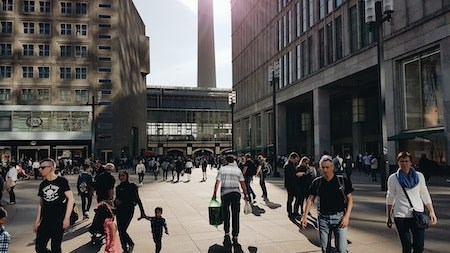For the first time in many months, Rode’s Report for the South African Property Industry for the first quarter of 2022 reports some noteworthy improvements.
This is in spite of the Russia‐Ukraine war raising expectations of higher inflation and interest rates and simultaneously increased concerns about global economic growth.
WATCH : Rode Report
The report found that:
- The industrial property market continues to perform well.
- The retail market is performing better.
- The office market is still sluggish, but some positive signs are emerging even here. These include improved market rentals compared to the end of 2021 and only slightly higher vacancies.
- Rental flats are filling up slowly in the residential market, but real rentals and house prices are still lagging.
Industrial
The industrial property market continued to perform well during the first quarter of 2022. Nominal rental growth increased to 4.1% year on year because of continued low vacancies resulting from a recovery in the manufacturing and retail sectors.
Rode Report editor, Kobus Lamprecht, says that in real terms, rentals increased at about the same pace as building cost inflation (BER BCI).
“Nominal rental growth has accelerated after growing by 0.5% in 2020 and 2.2% in 2021. This means this sector is still comfortably the best performer of the major commercial sectors where vacancies are much higher, especially the office market.”
He says that a key reason for the sterling performance of industrial property is the largely non-speculative nature of developments.
“Logistics has been doing exceptionally well. Nominal rentals for prime industrial space of 500m2 grew by 6.7% year on year in Cape Town during the first quarter of 2022. This is still above pre-pandemic levels,” says Lamprecht.
“This was the strongest growth of the major industrial conurbations. On Rode's vacancy scale, Cape Town's vacancy factor decreased sharply to 3.1. This implies a vacancy percentage of just above 5% – the lowest since the end of 2020 after almost a year of lockdowns.”
Capitalisation rates in Cape Town have also moved lower over the past few quarters, so Rode's panellists view this sector in a more positive light than before.
Rentals for central Witwatersrand and Durban also continue to perform well, growing by 4.1% and 4.3% respectively. According to Rode's survey results, vacancies generally still seem to be quite low - less than 5%. Rental growth was more subdued in the East Rand (+1.1%) and the Far East Rand (+1.7%). The report showed that vacancies remain highest in Gqeberha (Port Elizabeth) and Bloemfontein.
Office
Of the commercial property markets, the office sector continues to be the worst, with the national decentralised vacancy rate for grades A+, A, and B combined increasing further to 4.4 points during the first quarter of 2022. According to Rode's office vacancy survey, this is up from 4.3 points during the fourth quarter of 2021.
The average vacancy rate is now 14.7%, which is far above the long-term average of 8.8% since 2020, says Lamprecht.
“Because of the continuing oversupply of office space, tenants are in the driving seat and are clinching great deals - and at lower rentals. Rode’s latest office market survey shows that market gross rentals for decentralised Grade-A office space nationwide decreased year on year by 2% in nominal terms during the first quarter of 2022. This is the seventh consecutive quarter showing a drop in rentals.”
Lamprecht believes it is encouraging that the decline in rentals has eased gradually since mid-2021, when rentals fell by about 6% compared to 2020.
“In fact, rentals are up about 1% from the fourth quarter of 2021. This could be an early sign that the worst is over and that rentals are stabilising at lower levels. This could be a result of more workers going back to offices as Covid-19 becomes less of a factor.”
He points out, though, that the above rentals are nominal. This means that no allowances, tenant installations, rental remissions, or a number of months rent-free are assumed. ‘Nominal’ can also mean that the rental has not been deflated (with inflation taken out).
“Regionally, Cape Town has exceeded expectations, with rentals shooting up from the low levels at the end of 2021. However, rentals for all the major cities are still lower than in the first quarter of 2021, indicating that the office market is still feeling the heat,” says Lamprecht.
“During the first quarter of 2022, Grade-A nominal rentals - not deflated - decreased by 4.5% in Cape Town decentralised compared to the same quarter in 2021. Rentals declined by 2% year on year in Johannesburg and Pretoria. Yet again, this means that none of the major cities managed to record above-inflation rental growth compared to a year ago.”
Residential
Rode’s Report found that the housing market had a steady start to 2022. During the first two months, nominal prices increased by 3.8% year on year, which was slower than the 4.2% growth for the entire year of 2021.
However, in real terms, house prices have decreased by about 2% so far in 2022 due to the sharp rise in consumer inflation to 5.7%. At this stage, Lamprecht says, it is highly likely that real house prices will decline for the seventh consecutive year in 2022.
“Slower house price growth was expected given the fading impact of low interest rates amid record-high unemployment and an economy that is struggling to get back to pre-pandemic levels.”
According to Rode’s residential survey data, flat vacancies averaged 9.9% during the first quarter of 2022. This is down slightly from 10.2% during the fourth quarter of 2021.
Generally, vacancies have improved after hitting a peak of 13.1% during the fourth quarter of 2020. However, vacancy rates remain well above the 5.3% average recorded from 2017 to 2019 before the pandemic, implying that they are still relatively high.
Understandably, high vacancy rates have put significant pressure on rentals. Official data from Stats SA show that nominal flat rentals in South Africa during the fourth quarter of 2021 declined by 0.2% compared to a year earlier. This is the first time that rentals have moved into negative territory since at least 2009.
However, PayProp data shows that rentals surprisingly increased during the fourth quarter of 2021, with a growth of +0.8% year on year. Lamprecht says that rentals are still declining in real terms after adjusting for consumer inflation. This means that landlords are generally under pressure as costs are rising faster than their income. Higher interest rates also mean increased bond instalments.
Interest rates
Interest rates have entered a rising cycle to counter higher inflation. The prime rate ended March 2022 at 7.75% - up from its pandemic low of 7% during October 2021.
“At this stage, the impact of the interest rate hike is not significantly slowing house prices and sales volumes,” says Lamprecht.
“However, this is expected to change as rates increase further. Inflation and interest rate expectations have generally been raised since the last Rode Report in December 2021. This is due to the impact of further increases in fuel and food prices resulting from the Russia-Ukraine war.”
Nobody knows for sure by how much interest rates will be hiked and how quickly. The next meeting of the South African Reserve Bank's Monetary Policy Commission in May should indicate what the immediate future holds.
Writer : Sarah-Jane Meyer




